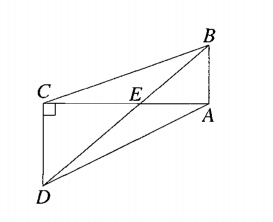The quadrilateral ABCD is a parallelogram with diagonal AC perpendicular to CD. The two diagonals intersect at E. How do you show that #DE^2 + 3EA^2 = AD^2#?
The question says to use Pythagoras' Theorem and to let CA=2d, CD=a and DA=c.

The question says to use Pythagoras' Theorem and to let CA=2d, CD=a and DA=c.
1 Answer
Apr 29, 2018
Explanation:
#"using a "color(blue)"property of parallelograms"#
#• " the diagonals bisect each other"#
#rArrCE=EA" and "BE=DE#
#"using "color(blue)"Pythagoras "" in "triangleDCE#
#DE^2=CE^2+CD^2#
#rArrDE^2=EA^2+CD^2larr(CE=EA)#
#rArrCD^2=DE^2-EA^2#
#"using "color(blue)"Pythagoras ""in "triangleCDA#
#AD^2=CA^2+CD^2#
#color(white)(AD^2)=CA^2+DE^2-EA^2#
#color(white)(AD^2)=(2CE)^2+DE^2-EA^2#
#color(white)(AD^2)=4EA^2+DE^2-EA^2#
#color(white)(AD^2)=3EA^2+DE^2#
#rArrDE^2+3EA^2=AD^2larr" as required"#
